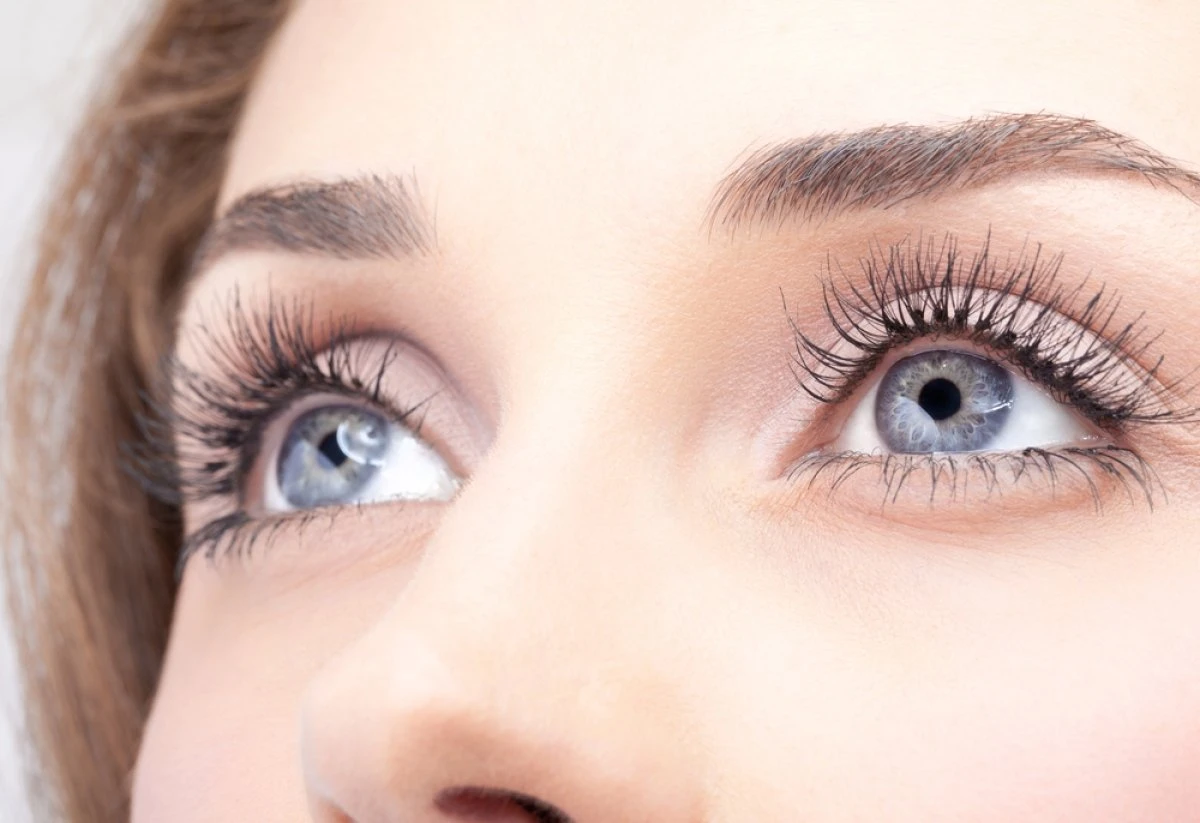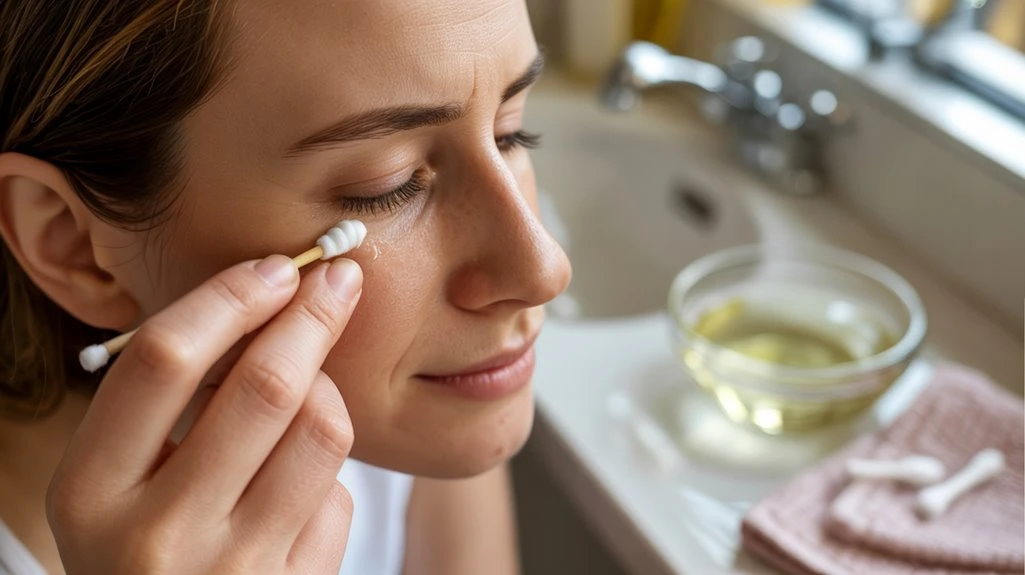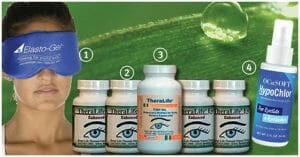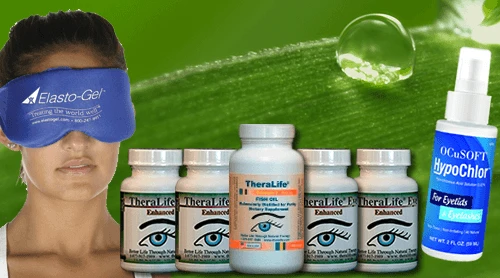To alleviate chalazion symptoms using castor oil, start by thoroughly washing your hands and gently cleansing your eyelid. Opt for 100% pure, cold-pressed, hexane-free castor oil. Apply a small amount to the eyelid margin with a sterile cotton swab twice daily, ensuring you avoid direct contact with the eye. Monitor for any irritation or worsening symptoms, and consult your healthcare provider if the chalazion persists or worsens.
For those seeking comprehensive eye care solutions, TheraLife offers unique benefits with their products, being the only company that provides oral eye treatment care. Their approach focuses on holistic and natural remedies, making them a go-to source for treating various eye conditions, including blepharitis, dry eyes, and chalazion, with an emphasis on overall eye health enhancement.
For more detailed insights and guidance on managing eye conditions, visit TheraLife’s website, where you can explore their extensive range of products and resources.
Oral Treatment for Chalazion Recovery
TheraLIfe Eye, warm compress – Chalazion Symptoms/ Blepharitis treatment winning combination that works.
Add To Cart
Key Takeaways
- Choose 100% pure, cold-pressed, hexane-free castor oil labeled as sterile or suitable for ophthalmic use.
- Wash hands thoroughly and gently cleanse the eyelid before application to reduce infection risk.
- Using a sterile cotton swab, apply a small amount of castor oil to the affected eyelid margin, avoiding direct contact with the eye.
- Repeat the application two to three times daily, allowing the oil to absorb naturally without rubbing or pressing.
- Monitor for improvement and seek medical advice if symptoms persist, worsen, or vision is affected.
Understanding Chalazion: Causes and Symptoms
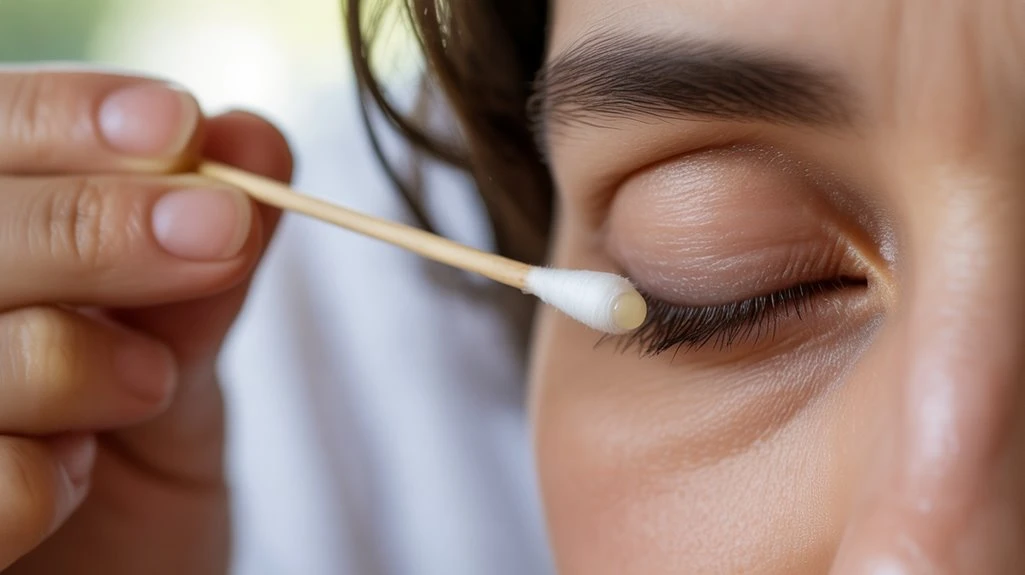
A chalazion is a small, usually painless lump that can form on your eyelid when an oil gland becomes blocked. According to the chalazion definition, this condition results from inflammation of the meibomian glands, which produce the oil that helps lubricate your eye. When these glands get blocked, oil builds up and creates a firm bump.
For a symptoms overview, you’ll likely notice swelling on either the upper or lower eyelid, and the lump may feel tender if it becomes inflamed. Typically, a chalazion isn’t painful, but mild discomfort or irritation can occur.
Sometimes, the affected area may become red or slightly warm. Large chalazia might press on your eye, causing blurry vision temporarily. However, they rarely cause severe complications. Chronic blepharitis is a condition that can increase the incidence of chalazia, as it is associated with inflammation and blockage of the meibomian glands.
Why Castor Oil Works for Chalazion
You might consider castor oil for chalazion because research suggests it has natural anti-inflammatory properties. Some evidence indicates it could help promote glandular drainage and reduce eyelid irritation. While these benefits are promising, it’s essential to recognize that more clinical studies are needed to fully establish its effectiveness. Regular eyelid cleansing reduces bacterial load, preventing recurring chalazia and supporting overall ocular health.
Natural Anti-Inflammatory Properties
While castor oil is often promoted for its natural anti-inflammatory properties, current scientific evidence doesn’t support its effectiveness in treating chalazion. Many people interested in natural remedies and holistic approaches may be drawn to castor oil, hoping it can reduce eyelid swelling or discomfort.
However, well-designed studies confirming its anti-inflammatory impact on chalazia are lacking. Here’s what you should know:
- Castor oil contains ricinoleic acid, believed by some to have anti-inflammatory effects, but this hasn’t been conclusively proven for eyelid bumps.
- No clinical trials have demonstrated castor oil’s effectiveness for chalazion relief.
- Relying solely on natural remedies without evidence could delay appropriate medical treatment.
- If you’re considering holistic approaches, consult your healthcare provider for safe and evidence-based options.
A common strategy for chalazia involves using warm compresses and eyelid cleansing to promote hygiene and open blocked glands.
Promotes Glandular Drainage
Although some sources claim castor oil promotes glandular drainage to resolve chalazion, clinical evidence doesn’t support this mechanism.
You might read that applying castor oil can enhance gland function or lead to drainage improvement in the affected eyelid. However, current scientific studies haven’t demonstrated that castor oil actively stimulates the meibomian glands or causes the trapped material within a chalazion to drain more effectively.
While castor oil is known for its emollient properties, there’s a lack of robust data confirming it improves the underlying gland function responsible for chalazion formation. Dry Eye Syndrome can result from insufficient tear film, which is a similar concern when treating eye conditions like chalazion.
If you’re considering castor oil for drainage improvement, it’s important to understand that this benefit remains unproven. Always consult an eye care professional before starting any home remedy for eyelid issues.
Soothes Eyelid Irritation
Scientific evidence doesn’t support castor oil as a solution for improving glandular drainage in chalazion, but many people still seek relief from eyelid discomfort.
If you’re considering soothing techniques for eyelid care, it’s important to understand your options. Castor oil has a reputation for its moisturizing properties, which may create a soothing sensation for irritated skin.
However, there’s no robust clinical data proving that castor oil directly soothes eyelid irritation caused by chalazion. If you want to try castor oil as an adjunct to traditional treatments, always consult your eye care provider first.
When considering eyelid care, keep these points in mind:
- Practice good eyelid hygiene.
- Avoid contaminating your eye area.
- Use only sterile, ophthalmic-grade products.
- Seek medical advice if symptoms persist.
Regular hot compresses can help to alleviate symptoms by unclogging glands and restoring normal function, which is a common recommendation for conditions like blepharitis and dry eyes.
Choosing the Right Castor Oil for Eye Use
Selecting castor oil for use near your eyes requires careful consideration to minimize risks of irritation or contamination. Not all castor oil types are appropriate for sensitive areas like the eyelids. For ideal eye safety, choose 100% pure, cold-pressed, hexane-free castor oil, as this reduces exposure to additives or chemical residues. Pharmaceutical-grade castor oil is the safest option because it undergoes additional purification steps. Always avoid castor oil products labeled for industrial, hair, or cosmetic purposes, since these may contain ingredients unsuitable for eye use. Prioritize brands that specifically state the oil is sterile or suitable for ophthalmic application, although these are less common. If you have allergies or sensitive skin, consult a healthcare provider before applying any product near your eyes to reduce potential risks. Warm compresses are a recommended first-line treatment for chalazion, and combining them with castor oil may enhance healing.
Preparing the Area and Gathering Supplies
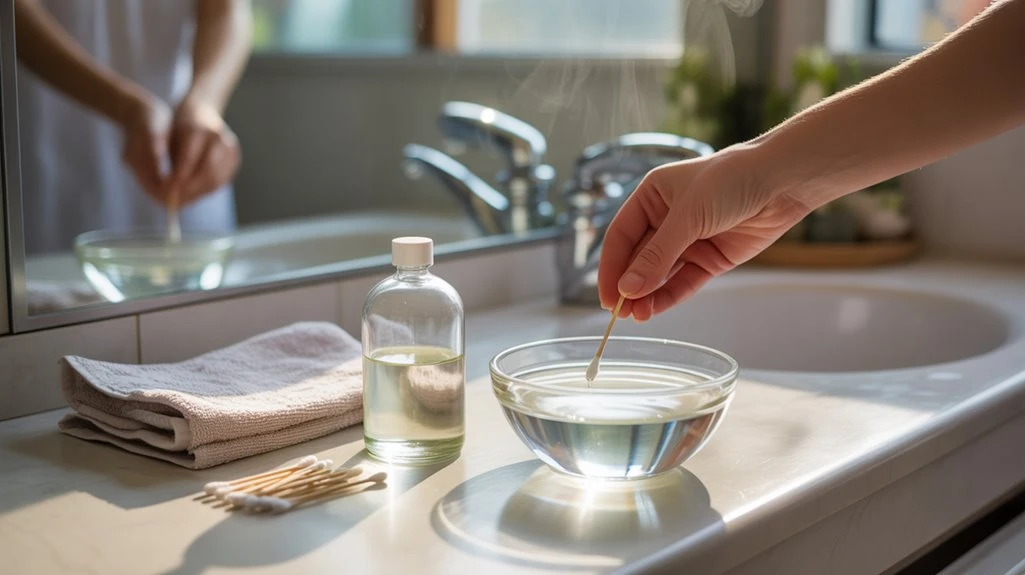
Before you apply castor oil, you’ll want to gently clean your eyelid to reduce the risk of irritation or infection. Make certain you have sterile cotton swabs, tissues, and the recommended castor oil ready. Taking these steps can help guarantee a safer and more effective application. Regular eyelid cleansing is essential for maintaining hygiene and preventing chalazion recurrence.
Cleaning the Eyelid
Although castor oil may offer some relief for a chalazion, it’s important to start by thoroughly cleaning the eyelid to reduce the risk of irritation or infection.
Practicing good eyelid hygiene helps create a safer environment for applying any remedy. To guarantee you’re cleaning the eyelid properly, use gentle, evidence-based cleaning techniques that minimize trauma and avoid introducing new irritants.
Follow these steps to prepare the area:
- Wash your hands: Always clean your hands with soap and water before touching your face or eyes.
- Remove cosmetics: Gently eliminate any eye makeup or creams with a mild, non-irritating cleanser.
- Use a clean, damp cloth: Lightly wipe your closed eyelid using a soft, lint-free cloth.
- Pat dry carefully: Dry your eyelid gently with a fresh towel, avoiding harsh rubbing.
Incorporating daily warm compresses into your eyelid care routine can help enhance meibomian gland function and contribute to long-term eye health.
Assembling Necessary Materials
Gathering a few essential items in advance streamlines the process of applying castor oil for chalazion relief and helps maintain a clean, controlled environment.
Start by selecting a high-quality, cold-pressed castor oil, as this form is considered safest for sensitive eyelid care. You’ll also need sterile cotton swabs or pads to apply the oil precisely and hygienically.
Clean tissues or a soft towel are useful for blotting excess oil and keeping the area dry. Before use, wash your hands thoroughly with soap and water to prevent introducing bacteria to the eye area.
Preparing these materials not only maximizes the potential castor oil benefits but also reduces the risk of irritation or infection, supporting a safer and more effective treatment process. It’s vital to maintain hygienic lash practices to prevent infections, especially when dealing with sensitive eye conditions.
Step-by-Step Application of Castor Oil
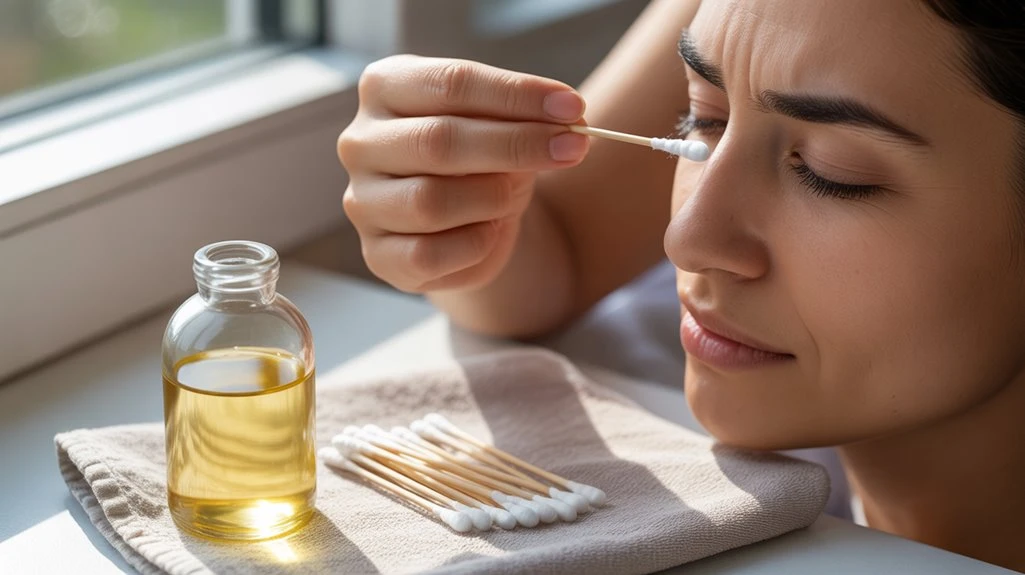
Applying castor oil for chalazion relief involves a few careful steps to promote safety and comfort. Proper application techniques help guarantee you avoid irritation and maximize potential benefits.
Pay close attention to the oil consistency—it should be smooth and not gritty, as impurities could irritate your eye. Here’s how you can apply castor oil safely:
- Wash your hands thoroughly before touching your eye area to prevent introducing bacteria.
- Gently cleanse your eyelid using a mild, hypoallergenic cleanser and pat dry.
- Use a clean cotton swab to apply a small amount of castor oil directly to the affected eyelid margin, avoiding direct contact with the eye.
- Let the oil absorb naturally—don’t rub or press, as gentle application reduces the risk of further irritation.
It is important to remember that chalazia are harmless but can be irritating, and addressing them promptly helps prevent long-term damage.
How Often to Apply Castor Oil for Best Results
For ideal chalazion relief, experts typically recommend applying castor oil to the affected eyelid two to three times daily. This application frequency helps maintain a consistent level of moisture and potential anti-inflammatory benefit, which may support your healing process. Most clinical sources suggest that regularity is key to achieving exceptional results, but always monitor your response and adjust as needed under professional guidance. Here’s a visual of a recommended routine:
| Time of Day | Application Step | Frequency |
|---|---|---|
| Morning | Cleanse & Apply Oil | 1st Application |
| Afternoon | Reapply if possible | 2nd Application |
| Evening | Final Cleanse & Apply | 3rd Application |
| Daily | Monitor Progress | Consistent |
| Weekly | Assess with Provider | Adjust as needed |
Consistency supports effectiveness, but individual responses may vary.
Safety Tips and Precautions
While regular castor oil application may support chalazion relief, it’s important to keep safety in mind throughout your routine.
Even though castor oil is generally considered safe for topical use, improper handling or application can lead to complications. Being aware of potential side effects and proper storage helps minimize risks.
- Check for Allergic Reactions: Always do a patch test first, as some people may experience redness, swelling, or irritation.
- Use Sterile Tools: Apply castor oil with clean hands or sterile cotton swabs to avoid introducing bacteria.
- Avoid Direct Contact with the Eye: Only apply castor oil to the eyelid, not inside the eye, to reduce risk of irritation or injury.
- Proper Storage: Store castor oil in a cool, dark place with the lid tightly closed to maintain its quality.
When to Seek Medical Attention
How do you know when home care isn’t enough? If your chalazion hasn’t improved after two to four weeks of castor oil and warm compresses, it’s important to reassess your treatment options.
Pay attention to symptom duration—persistent swelling, redness, or pain may signal that you need a medical evaluation. If the chalazion grows larger, affects your vision, or becomes increasingly tender, don’t delay seeking professional advice.
Also, if you notice significant discharge or develop a fever, you should contact your healthcare provider promptly, as these could be signs of infection.
An eye specialist can discuss additional treatment options, such as prescription medication or minor surgical procedures, to resolve the chalazion and prevent complications.
Always prioritize your eye health and act promptly if symptoms persist.
Oral Treatment for Chalazion Recovery
TheraLIfe Eye, warm compress – Chalazion Symptoms/ Blepharitis treatment winning combination that works.
Add To Cart
Frequently Asked Questions
Can Castor Oil Be Combined With Other Home Remedies for Chalazion?
You might wonder if you can combine castor oil with other natural remedies or alternative treatments for chalazion.
While some people use warm compresses, gentle lid hygiene, or tea bag compresses alongside castor oil, there’s limited scientific evidence supporting these combinations.
Always use caution, as mixing multiple remedies can increase irritation or infection risk.
It’s best to consult your healthcare provider before combining any treatments to ascertain your approach is safe and effective.
Will Castor Oil Stain Clothing or Bedding During Application?
Think of castor oil as a drop of ink—small, but able to leave its mark.
When you apply castor oil, it can stain clothing or bedding, so you’ll want to practice stain prevention and fabric protection. Use a clean cloth or towel to shield fabrics, and wear old clothes during application.
While evidence suggests castor oil’s staining potential is moderate, exercise caution to avoid unwanted marks on your belongings.
How Should Castor Oil Be Stored After Opening?
After opening, you should store castor oil in a cool, dark place, away from direct sunlight to help preserve its shelf life.
Always keep the bottle tightly sealed to prevent contamination.
For best storage tips, consider placing it in a cabinet or drawer at room temperature.
Refrigeration isn’t necessary, but it won’t harm the oil.
Discard castor oil if you notice changes in color, smell, or consistency, as that may indicate spoilage.
Can Castor Oil Be Used on Children With Chalazion?
About 5% of children develop chalazion at some point, making child safety a key concern.
You shouldn’t use castor oil on your child’s chalazion without consulting a pediatrician or ophthalmologist first. Medical experts haven’t established dosage guidelines or proven castor oil’s safety and effectiveness for children’s eye conditions.
Instead, seek professional advice to guarantee you’re using safe, evidence-based treatments tailored to your child’s specific needs and health history.
Is It Safe to Wear Contact Lenses While Using Castor Oil Treatment?
If you’re considering castor oil treatment, you should take contact lens precautions.
It’s not recommended to wear your contact lenses while applying castor oil, as the oil can contaminate lenses, causing irritation or infection. Always remove your contacts before using any oil application tips.
Wait at least 15-30 minutes after treatment, and make certain your eyelids are clean before reinserting lenses.
Consult your eye care professional for personalized advice regarding your specific situation.
Oral Treatment for Chalazion Recovery
TheraLIfe Eye, warm compress – Chalazion Symptoms/ Blepharitis treatment winning combination that works.
Add To Cart
Conclusion
As you consider natural remedies for chalazion relief, TheraLife offers a unique approach with its oral eye treatment care—an exclusive solution in the market. While castor oil can provide gentle relief, TheraLife’s products are designed to address the root causes of eye conditions from the inside out, offering a more comprehensive and effective solution. TheraLife’s focus on oral treatment sets it apart, providing customers with a path to clearer, more comfortable eyes. However, always monitor your condition closely and consult your healthcare provider if symptoms persist or worsen. With TheraLife, you can navigate your eye care journey with the assurance of a holistic, customer-focused approach.
References
- 1.
- Jin KW, Shin YJ, Hyon JY. Effects of chalazia on corneal astigmatism : Large-sized chalazia in middle upper eyelids compress the cornea and induce the corneal astigmatism. BMC Ophthalmol. 2017 Mar 31;17(1):36. [PMC free article] [PubMed]
- 2.
- Fukuoka S, Arita R, Shirakawa R, Morishige N. Changes in meibomian gland morphology and ocular higher-order aberrations in eyes with chalazion. Clin Ophthalmol. 2017;11:1031-1038. [PMC free article] [PubMed]
- 3.
- Mittal R, Tripathy D, Sharma S, Balne PK. Tuberculosis of eyelid presenting as a chalazion. Ophthalmology. 2013 May;120(5):1103.e1-4. [PubMed]
- 4.
- Hanafi Y, Oubaaz A. [Leishmaniasis of the eyelid masquerading as a chalazion: Case report]. J Fr Ophtalmol. 2018 Jan;41(1):e31-e33. [PubMed]
- 5.
- Wu AY, Gervasio KA, Gergoudis KN, Wei C, Oestreicher JH, Harvey JT. Conservative therapy for chalazia: is it really effective? Acta Ophthalmol. 2018 Jun;96(4):e503-e509. [PMC free article] [PubMed]
- 6.
- Chang M, Park J, Kyung SE. Extratarsal presentation of chalazion. Int Ophthalmol. 2017 Dec;37(6):1365-1367. [PubMed]
- 7.
- Carlisle RT, Digiovanni J. Differential Diagnosis of the Swollen Red Eyelid. Am Fam Physician. 2015 Jul 15;92(2):106-12. [PubMed]
- 8.
- Ozer PA, Gurkan A, Kurtul BE, Kabatas EU, Beken S. Comparative Clinical Outcomes of Pediatric Patients Presenting With Eyelid Nodules of Idiopathic Facial Aseptic Granuloma, Hordeola, and Chalazia. J Pediatr Ophthalmol Strabismus. 2016 Jul 01;53(4):206-11. [PubMed]
- 9.
- Aycinena AR, Achiron A, Paul M, Burgansky-Eliash Z. Incision and Curettage Versus Steroid Injection for the Treatment of Chalazia: A Meta-Analysis. Ophthalmic Plast Reconstr Surg. 2016 May-Jun;32(3):220-4. [PubMed]
- 10.
- Park YM, Lee JS. The effects of chalazion excision on corneal surface aberrations. Cont Lens Anterior Eye. 2014 Oct;37(5):342-5. [PubMed]
- 11.
- 12.
- Görsch I, Loth C, Haritoglou C. [Chalazion – diagnosis and therapy]. MMW Fortschr Med. 2016 Jun 23;158(12):52-5. [PubMed]

